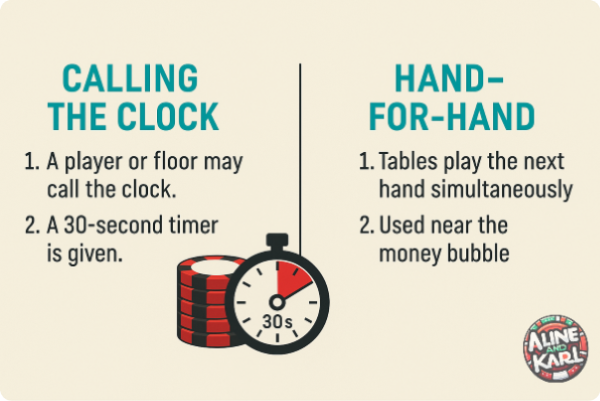⏰ Stalling in Poker: Borderline Strategy or Unsportsmanlike Behavior?
🎯 Introduction – When Time Becomes a Weapon
Imagine this: we’re in the middle of a tournament, just a few eliminations away from a significant payout jump. A player, aware of the situation, faces a decision… and starts thinking. One minute. Two minutes. Three minutes. The table grows restless, glances are exchanged. Is this player simply trying to make the best decision… or using time as a weapon to move up in the payout structure?
🏆 A Case That Made Headlines: WSOP Main Event 2025
During the 2025 Main Event, a player was down to a single chip. Instead of acting quickly, he took… six minutes to “think” about his move. Meanwhile, another player at a different table was eliminated, allowing him to move up in the payouts without risking his last chip.
Pro Daniel Negreanu, who witnessed the scene, called it an obvious angle shoot:
“There’s no reason to tank like that except to steal a payout jump.”
This perfectly illustrates the dilemma: clever tactics or behavior against the spirit of the game?
🤔 Why Some Players Do It
Stalling (deliberately slowing down the game) is often motivated by:
- Reaching a payout jump: every elimination can mean a significant increase in prize money.
- Avoiding the blinds: stalling a few hands to preserve a short stack.
- Breaking the rhythm: frustrating opponents by slowing the pace.
For some, it’s simply strategic play. For others, it’s against the spirit of tournament poker.
📋 What the 2024 TDA Rules Say
- Rule 29 – Clock: Only a player or a floor can call the clock.
- Rule 70 – Ethics: Players must maintain a reasonable pace of play.
- Recommended Procedure RP-19 – Stalling: Floors must monitor deliberate slow play, especially in sensitive stages.
👥 Different Points of View
- The player: “I’m maximizing my chances; it’s within the rules.”
- The opponent: “You’re slowing down the game just for your advantage, it’s unfair.”
- The tournament director: “I must protect fairness and the pace of play, even if that means limiting your freedom to act.”
💡 Possible Solutions
To reduce abuse:
- Early hand-for-hand: start hand-for-hand several spots before the bubble or a major payout jump to neutralize stalling.
- Shot clock: limit decision time to 30 seconds per hand, with extra time chips for complex spots.
- Encouraging the clock: players should report excessive stalling to the floor promptly, regardless of the opponent’s reputation.
🎭 Conclusion – Where Do You Draw the Line?
Stalling sits in a gray area: not automatically illegal, but quickly punishable if deemed excessive or unethical. In the end, it’s up to the floor to decide, with one clear goal: preserve fairness and tournament integrity.
And you — if faced with a player tanking to move up a payout… would you call the clock?

